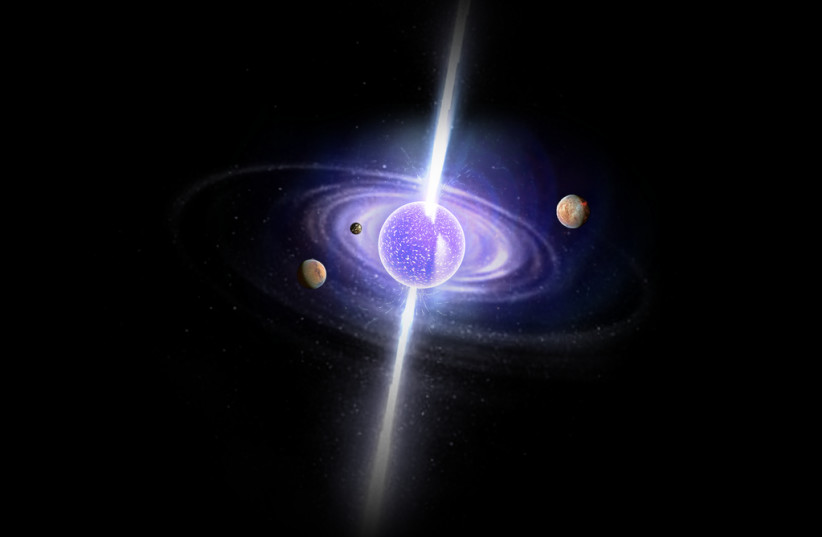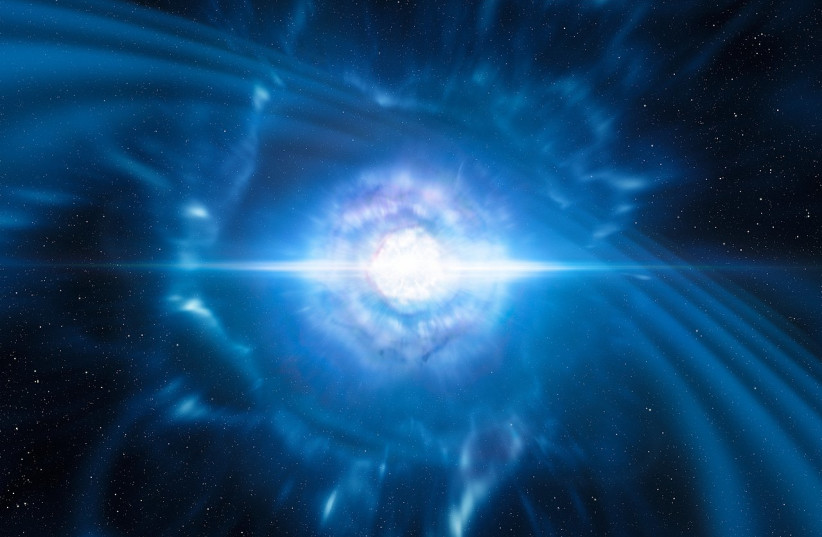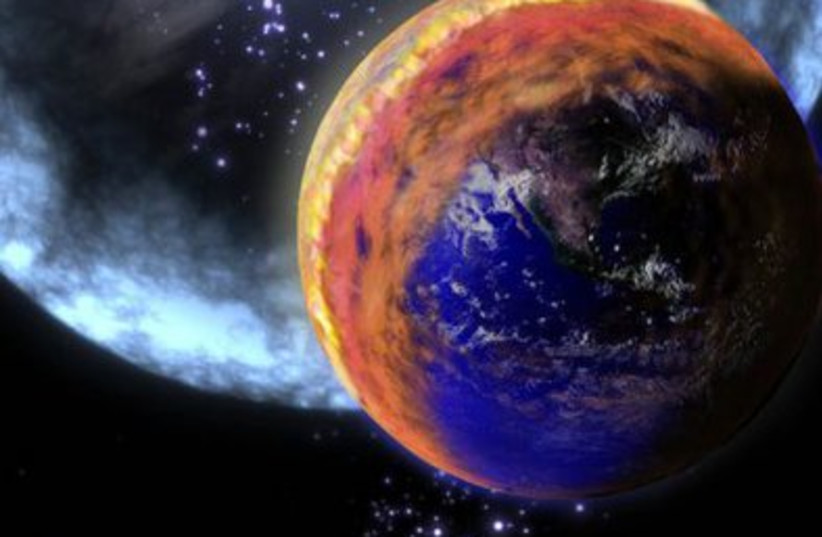Scientists have managed to capture images of one of the brightest and most energetic kinds of explosions in the universe that is powerful enough to literally create gold: A gamma-ray burst.
The observation, which was described in a study set to be published in the peer-reviewed academic periodical The Astrophysical Journal Letters, has allowed scientists to see this massive explosion, caused by a neutron star merging with another star, even if the burst itself only lasts a few tenths of a second.
Considering neutron stars themselves are also incredibly hard to detect, that makes this find especially out of this world.
<br>Gamma-ray bursts: Unleash more power than the Sun!
A gamma-ray burst (GRB) is essentially just a massive burst of the most energetic type of light: Gamma-ray light.
They don't usually last long — just a few milliseconds or a few minutes. But they make the most of their brief time in the spotlight.
According to NASA, they are much brighter than any supernova and around a million trillion times brighter than our Sun and moving at the speed of light. It becomes one of the single brightest things in the universe.
It is estimated that a single GRB will produce as much energy in just this short amount of time as our Sun will in the entirety of its 10-billion-year lifespan.
Not only that, but they are so powerful that they are likely a source of rare heavy metals like gold and platinum.
Despite this, it took a while for scientists to actually know they existed, having been suddenly picked up by US military satellites in the 1960s when they were trying to spot Soviet nuclear weapons testing violations.
Longer GRBs last anywhere between two seconds and just a couple of minutes. These are thought to have been caused by supernovas triggered by the death of a massive star.
But the shorter ones, which have an average duration of 0.3 seconds, have a different source: Neutron stars. Specifically, it is thought to come from either neutron stars merging or a neutron star falling into a black hole.
These short-duration GRBs are especially hard to see and generally speaking, scientists need to instead detect the afterglows — which is still difficult. The afterglows themselves are the result of the jets from the explosion interacting with the surrounding gas.

What is a neutron star?
Only the single densest thing in the universe outside of a black hole and some hypothesized exotic stars.
A neutron star is essentially one of the end fates of an extremely large star. The outward matter has blown away in a supernova and all that remains is its core, with a significant amount of mass now greatly condensed.
The sheer density of neutron stars is something quite literally astronomical. These originally came from stars that were 10 to 25 times the mass of the Sun. The resulting neutron star would then be 1.1 to 2.3 times the mass of the Sun.
But that's just the mass, not the physical size. In general, neutron stars are rather small and generally have diameters around 20 kilometers, all the while preserving the mass.
To put it simply, this is multiple times the mass of our Sun all condensed into a small ball the size of a city.
Another thing that makes neutron stars so fascinating is that they don't seem to be made up of normal atoms. Rather, the collapse of the star seems to have caused them to be formed entirely of neutrons, hence the name neutron star.

Now, how do neutron stars form GRBs?
They collide.
Many neutron stars are in binary systems, meaning they are part of a star system that has another star in it, with the two orbiting around each other.
But sometimes, they might spiral into each other, merging together. This results in it merging together, further exploding in a massive burst of light we know as a GRB.
As for what happens to the star itself, it likely continues to grow, but if it grows large enough and surpasses the Tolman–Oppenheimer–Volkoff limit - meaning it would be over three solar masses - then the neutron star would collapse in on itself and take on an even denser form - most likely resulting in the creation of a black hole.
Of course, that isn't the only way black holes are formed, and it also isn't necessarily the only fate, with some scientists hypothesizing the existence of further stars such as quark stars, but that remains unclear.

Watching a GRB like never before
All this time, scientists have only ever been able to detect a few different short-duration GRBs, all of which have been through radio wavelengths.
But what about something further? What about millimeter wavelengths? Every wavelength matters in these kinds of observations.
This isn't easy. It would need something like an incredibly powerful telescope.
In other words, it would take the Atacama Large Millimeter/Sub-millimeter Array (ALMA) telescope in Chile. And that is exactly what happened.
Scientists first detected the short-duration gamma-ray burst, identified as GRB 211106A, with early X-ray detection from NASA's Neil Gehrels Swift Observatory. But even then, it was still faint. They couldn't actually see where it came from.
To further explain, neutron stars, as stars are in galaxies. In fact, the Milky Way Galaxy likely has anywhere from several hundred million to billions of neutron stars. As such, these gamma-ray bursts have to come from somewhere, and scientists are always interested in finding out where.
This makes sense since, after all, it was through the tracking of explosions from the deaths of stars that astronomers have been able to get a much bigger picture and greater understanding of the universe as a whole.
Swift wasn't able to find the galaxy where GRB 211106A came from. NASA's Hubble Space Telescope also ran into issues, with dust obscuring its visuals.
Getting through this would require an instrument with considerable sensitivity, and ALMA was the right tool for the job, tracking it on millimeter wavelengths.
Using ALMA, the researchers were able to further narrow down where GRB 211106A came from - and it turns out, it was a lot farther away than they thought.
<br>What does that mean?
GRB 211106A was a lot stronger than they thought.
To be sure, that's incredibly significant and can help add to our knowledge of GRBs and neutron stars in general.
However, the most significant impact of this study was the success of the methodology, having been able to detect a GRB via millimeter wavelengths and through the use of multiple powerful telescopes like ALMA and Hubble and even the National Science Foundation’s Karl G. Jansky Very Large Array (VLA).
This is important, as when studying something like GRBs, as well as many other astronomical phenomena, the quick and rapid coordination of multiple powerful telescopes is essential. And this further proves the capabilities of these tools.
Further, telescope technology has considerably advanced in recent years. For example, there's the Gamma-ray Burst Localizing Instrument (GALI), developed by Profs. Ehud Behar and Shlomit Tarem of Technion-Israel Institute of Technology, which hopes to be a new kind of gamma-ray burst detector. It was brought to the International Space Station earlier in 2022 by Israeli astronaut Eytan Stibbe as part of the Rakia mission.
But there have been other advancements in telescopes, too.
NASA's recently launched James Webb Space Telescope is capable of feats unparalleled by other telescopes. Already, the data it has produced has expanded our visual perception of the universe, thanks to its state-of-the-art equipment and unparalleled level of sensitivity.
Through the use of the James Webb Space Telescope, it's possible to take infrared imaging, study the chemical composition of cosmic objects and more.
And as powerful as the James Webb Space Telescope is, scientists are hard at work producing other powerful telescopes for further use, such as the next generation VLA (ngVLA).
These telescopes will be able to study events like this even further, greatly expanding the possibilities of scientific discoveries in the vast expanse of the cosmos.

GRBs in the Milky Way?
An interesting thing to note: Despite the vast amount of neutron stars in the Milky Way Galaxy, scientists have never actually detected one here — only in other galaxies.
This is probably for the best, though, since that means there hasn't been a GRB spotted anywhere near Earth.
According to some scientists, should a gamma-ray burst happen in the Milky Way and be pointed at Earth, it could result in a mass extinction event. In fact, this may have actually happened once, and some scientists have theorized that a gamma-ray burst caused the Ordovician extinction - one of the five mass extinction events - around 450 million years ago, according to NASA.
Further, as a type of ionizing radiation, gamma rays are hazardous to human life. Indeed, they can easily pass through the human body and from many forms of radiation protection. Even mirrors are unable to reflect them.
